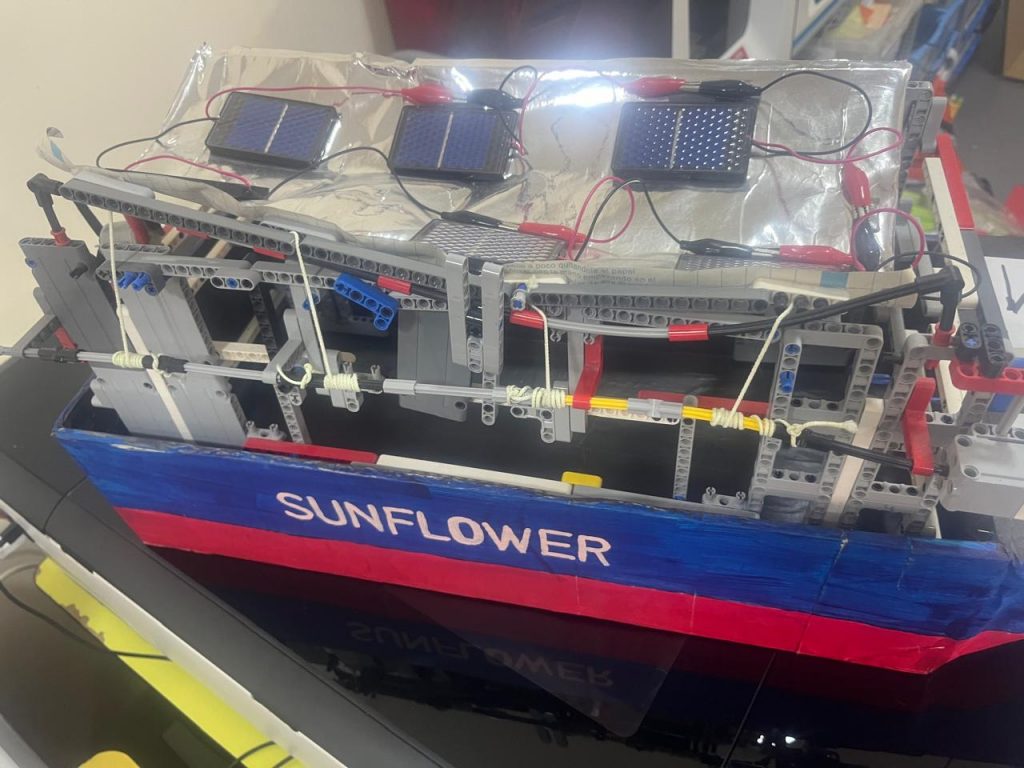Solar Powered Ship
School: Ambassador School, Dubai
Name of the Participants
The shipping industry is a major contributor to global pollution and energy consumption. Cargo ships, essential for global trade, primarily rely on fossil fuels, resulting in significant greenhouse gas emissions. These ships are also inefficient in terms of energy usage, especially under adverse weather conditions such as cloudy days when solar energy capture is limited. Our project aims to address these critical issues by introducing an innovative solution: the use of solar cloth technology to power cargo ships. This approach aims to save energy, reduce pollution, and promote sustainability within the shipping industry, contributing to a greener economy and supporting global efforts in green trade and commerce.
Name of the Participants
- The solar powered ship has the solar cloth which is researched in the French company and proves suitable to save solar energy .Special storage of energy is done when ship is docked.
- A solar-powered ship is a vessel that utilizes solar energy as its primary source of power to propel and operate various systems on board. This innovative approach addresses the environmental impact of traditional fossil fuel-powered ships and contributes to sustainable maritime transportation. Here are key features, functionalities, and strategies associated with solar-powered ships:
Solar cloth
The most prominent feature of a solar-powered ship is the installation of solar cloth on its surface. These panels are typically mounted on the deck or other suitable areas exposed to sunlight. The solar cloth convert sunlight into electrical energy through photovoltaic cells.
Energy Storage Systems
To ensure continuous power availability, solar-powered ships are equipped with energy storage systems, such as batteries. During periods of intense sunlight, excess energy generated by the solar panels is stored in these batteries. This stored energy is then used when sunlight is insufficient, such as during cloudy days or at night.
Energy-Efficient Design:
Solar-powered ships may incorporate energy-efficient design principles to minimize overall energy consumption. This can include lightweight materials, streamlined hulls, and optimized aerodynamics to enhance the ship’s efficiency.
Environmental Impact:
By using solar power, these ships significantly reduce greenhouse gas emissions and dependence on non-renewable resources. This eco-friendly approach aligns with global efforts to mitigate climate change and promote sustainable practices in the maritime industry.
Long-Term Cost Savings:
While the initial investment in solar-powered technology can be significant, the long-term operational costs are generally lower as sunlight, the primary fuel source, is abundant and free. This cost-effectiveness becomes increasingly attractive over the lifespan of the vessel.
Traditional Fuel-Powered Ships vs. Solar-Powered Ships
Energy consumption & Cost savings
Traditional Fuel-Powered Ships
- Average fuel consumption: 100-300 tons of fuel per day for large cargo ships.
- Fuel cost: Approximately $300-$700 per ton (varies by fuel type and market conditions).
- Daily fuel cost: $30,000 to $210,000.
Solar-Powered Ships with Solar Cloth (SUNFLOWER)
- Average solar energy capture: Up to 10 MWh per day (depending on size and efficiency of solar cloth).
- Reduction in fuel consumption: Up to 80% on sunny days.
- Estimated annual fuel savings: $5 million to $30 million per ship (depending on size, route, and solar energy availability).
STEAM Elements Incorporated
Science
Solar Energy Conversion: Understanding the principles of photovoltaics and solar radiation to effectively convert sunlight into electrical energy .This can be long lasting using solar cloth. Environmental Impact Assessment: Applying scientific methods to assess and quantify the environmental benefits of utilizing solar power in maritime transportation.
Technology
Solar cloth and Photovoltaic Technology: Implementing advanced solar cloth technology for efficient energy capture and conversion.
Engineering
Ship Design: Integrating solar cloth into the ship’s structure while considering factors like weight distribution, aerodynamics, and structural integrity.
Electrical Systems Engineering
Designing and optimizing electrical systems for energy storage.
Material Science
Selecting materials that are lightweight, durable, and suitable for the marine environment and sustainable.
Arts
Aesthetic Integration: Incorporating solar cloth into the ship’s design in a visually appealing and easily functional manner as its durable and flexible. Communication and Outreach: Using artistic elements to effectively communicate the eco-friendly features of the solar-powered ship to the public and stakeholders.
Mathematics
Energy Calculations: Performing mathematical modeling to estimate energy production, consumption, and storage requirements with data and analysis.
Our Project meets Sustainable developmental goals SDG 7,9,12and 13
- Ensuring universal access to affordable electricity by 2030 means investing in clean energy sources such as solar, wind and thermal. Adopting cost-effective standards for a wider range of technologies could also reduce the global electricity consumption by buildings and industry by 14 percent.
- SDG 7 Affordable and clean energy.
Ensure access to affordable, reliable, sustainable and modern energy for all
- SDG 9 Industry, innovation and infrastructure.
Build resilient infrastructure, promote inclusive and sustainable industrialization and foster innovation
- SDG12 Responsible consumption and production.
Ensure sustainable consumption and production patterns
- SDG 13 Climate action .
- Take urgent action to combat climate change and its impacts
Impact and potential of Solar powered ship
- The project has greater potential for real-world application not only in ships but also in boats for further development. It has the potential to create maximum Co2 reduction and change which contribute to the field of clean energy.
- The integration of solar-cloth in ships in marine environment not only offers environmental and economic benefits but also provides with valuable experimental experiences, promotes health and well-being, and encourages a mindset focused on sustainability and innovation.
- Encourages research and development to promote start-ups in not only in shipping industry but various other arenas where solar energy can be saved and utilized to prevent climatic changes. Encourages larger plethora of subject to study and have rare career choices.
- Outcomes and impacts are decreased dependence on fossil fuels, encourages technological Innovation , Learning about sustainable practices, Improved air quality, lower operating costs, motivation for future innovations.



